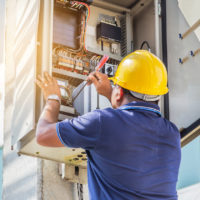Breaker, Breaker

If you have a circuit breaker that keeps getting tripped, it’s time to call an electrician or figure out what’s going on before someone gets hurt
Do you have a circuit breaker that is constantly being tripped, sending you over and over to the breaker box to get the power going again? Your breaker box is trying to tell you something. It’s telling you that your outlet is overloaded or your wiring is malfunctioning for some reason. If this is happening, it’s important to figure out what’s going wrong and fix it. An electrical problem could lead to serious injury and property damage if a family member gets shocked or electrocuted at the outlet, or if the problem starts an electrical fire in the home.
Below is some basic information about household circuit breakers. If your problem is not easily fixable (like unplugging a lamp), it’s best to call a licensed electrician if you are inexperienced dealing with electrical issues.
What causes a trip?
A circuit breaker is designed to trip or literally break the circuit to prevent an outlet from becoming overloaded. This can happen if you are plugging too many devices into an outlet buy using an outlet adapter or expander, or if the products plugged into the outlet are drawing too much power.
If the devices themselves don’t seem to be causing the problem, there may be faulty wiring at the outlet, the breaker box or anywhere in between. This is particularly dangerous, because a faulty wire or short circuit could start an electrical fire that could cause serious damage and even burn down the home. At a minimum, a short-circuit or overloaded circuit could damage a sensitive (and expensive) piece of electrical equipment.
How well do you know your breaker box?
Sometimes called a fuse box or a service panel, this box in your home receives electrical current from outside power lines and channels electricity to all the electrical plugs and outlets in your house. The box contains circuit breakers which can get “tripped,” cutting off the circuit, to prevent an outlet from being overloaded and damaging equipment or starting an electrical fire. You can also safely disconnect the power to an outlet simply by flipping the applicable circuit breaker to the off position. This is a safe way to disconnect power to an outlet before you begin any rewiring.
Can’t find the fuse box? Even though it’s a box, if it’s inside the house, it’s probably set into the wall, so it may just look like a door panel instead of a box. This is likely the case if it is located in a hallway or even a closet. It may also be in the garage or basement. Look for a gray metal door sized about 8”x10.” Of course, it may have been painted over to match the wall; if so, hopefully it wasn’t painted shut by an inexpert paint job. The box may be outside too, maybe near the power meter. There may even be more than one if the house is particularly large.
What’s the difference between a fuse box and a breaker box? Fuses are typically round and cylinder-shaped or are threaded at one end like a light bulb. Circuit breakers look like switches that you can flip on and off, usually horizontally. If you have a fuse box, you may need to replace a fuse that has burned out. A circuit breaker doesn’t often need to be replaced; you just need to reset the tripped breaker by flipping the switch all the way to the off position and then to the on position (a tripped breaker is likely to be somewhere between the off and on positions, making it easy to spot which circuit breaker was tripped).
What if the problem is faulty wiring?
If unplugging extra devices doesn’t stop the circuit breaker from tripping, you may need to inspect the wiring in your home. The safest way to do this is by calling an electrician. If you’re wanting to at least inspect the problem first on your own, make sure you DISCONNECT THE POWER to any outlet you are working with. At the breaker box, flip the applicable breaker to the off position. Hopefully, the breaker box will list the rooms or outlets for each circuit breaker, so you know which one to turn off if doing any wiring on an outlet. There will also be a master breaker or two that are somewhat larger than the other breakers; these breakers will shut off all power in the house (including the refrigerator, so work quickly).
Know what size wiring you need? Wire size is measured in terms of gauges, which relates to the thickness of the copper and its capacity to conduct electricity. Intuitively, the thicker or heavier the wire, the more electrical current it can carry. Counterintuitively, the heavier the wire, the smaller the gauge. For example, 14-gauge wire can carry a current up to 15 amps, while 12-gauge wire can safely carry current up to 20 amps without overheating.
The proper gauge wire for your home will depend on the amp rating of your breaker box. It’s very important to use the right gauge wire to avoid constantly tripping the circuit, which can happen if the gauge is too large, or far worse, starting a house fire (or getting electrocuted) due to using a wire with too small of a gauge.
Home improvement websites around the Internet can provide much more detail on how to safely and properly replace bad wires or fix loose ones. Did we mention calling an electrician if you’re not sure how to proceed?



